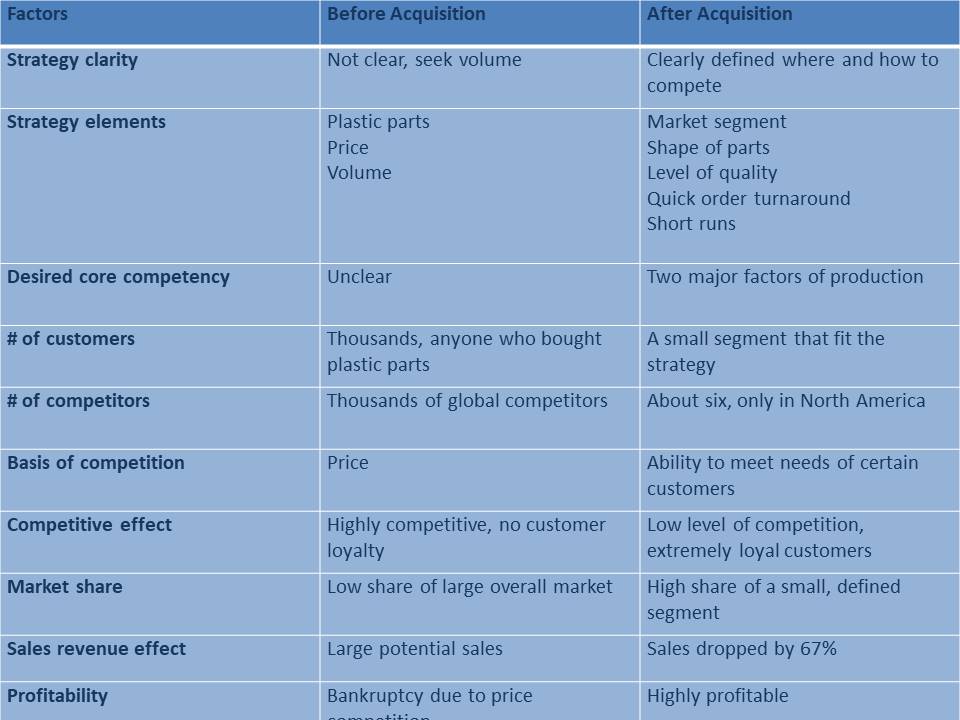I define business strategy as a description or statement of where and how an organization intends to compete. A longer version of this definition would be business strategy is a description of where and how an organization intends to compete, using the organization’s core competencies to meet customers’ needs and provide a compelling value to the customer. Sometimes it can be difficult to translate this rather academic definition into a real-life strategy. A case study of what strategy is and how it can transform a business can be helpful in developing our understanding.
Some years ago, two of my friends bought a business and transformed it simply by defining and implementing a great strategy. Of course, it took some effort to first define a great strategy and then to implement it by changing the way the business operated. On the other hand, the investment was primarily in thought and discipline.
The business happened to be an injection molding business. Before the acquisition, the company was a fairly large molder of plastic parts mainly for the automotive industry. While every business has a strategy of some sort, either explicit or implicit, it is hard to describe just what the strategy was before the acquisition. As with many of the thousands of injection molding businesses, the strategy could be described as “find and pursue any business that they could make.” That would be the where of strategy. The how of their strategy might be described as competing on price with a hope of building volume. Without any clear core competency or competitive advantage, the company competed mainly on price. And without anything to set it apart, it competed with hundreds or thousands of other companies with similar capabilities. Therefore, the company faced stiff price competition and customers that had no loyalty but would quickly switch suppliers for a lower price. Since they continually needed to give price concessions to keep their volume, it was not surprising that the business went into bankruptcy.
As my friends acquired the business out of bankruptcy, they defined a strategy for success. The impetus of the strategy was to utilize the productive capacity of the acquired company while developing some particular core competencies. The immediate impact of the new strategy was to fire most of the previous company’s customers and focus on a new set of customers, resulting in an immediate shrinking of the company to one-third of the sales revenue. However, the one-third of the revenue was more profitable than the previous company had ever been.
Their new business strategy had five elements that defined where and how they would compete. First, it defined the sorts of products that they thought they could produce well. Secondly, it defined the kinds of markets that they hoped to serve, and then it described what the expectations would be of their target customers and the skills that they would need to offer. There were two primary markets that they wished to serve, and these were narrowly defined, both expensive equipment markets. They knew that the producers of this sort of high-priced equipment would have high expectations for quality and that suited the company just fine. By the nature of these equipment markets, they expected that customers would demand short runs and much smaller quantities than the norm that they had dealt with before their business had collapsed. Also, these customers would demand quick order turnaround.
The newly-defined strategy was targeted at meeting a clear set of needs for a specific set of customers. By providing a clearly superior value to these customers, the strategy led to satisfied customers. More importantly, the strategy defined a market and way to compete that eliminated most of the potential competitors. For this particular set of customers and their needs, there were not many competitors who were able or willing to develop the capability to serve this segment.

The new strategy provided focus for the re-organized company. It identified the customers that they would and, by default, would not serve. It defined the products that they would and would not produce. Most importantly, it defined the two core competencies that they would pursue – 1) the ability to consistently make this type of part at the necessary levels of quality and 2) the ability to efficiently produce short runs with fast turnaround. With the strategy in place, they knew precisely what capabilities they needed to develop. The strategy then guided the equipment in which they invested, the skills and technology that they would develop, the employees that they would hire and promote, and other decisions that shaped the company. With a clear strategy that focused and guided all of their decisions, they became a very successful and profitable operation. Most importantly, the strategy defined the value that they would offer to their select set of customers so that they developed strong and stable relationships with their customers.
Does your organization have a clear and compelling strategy that guides your decisions and defines how you will succeed?

Add your comment